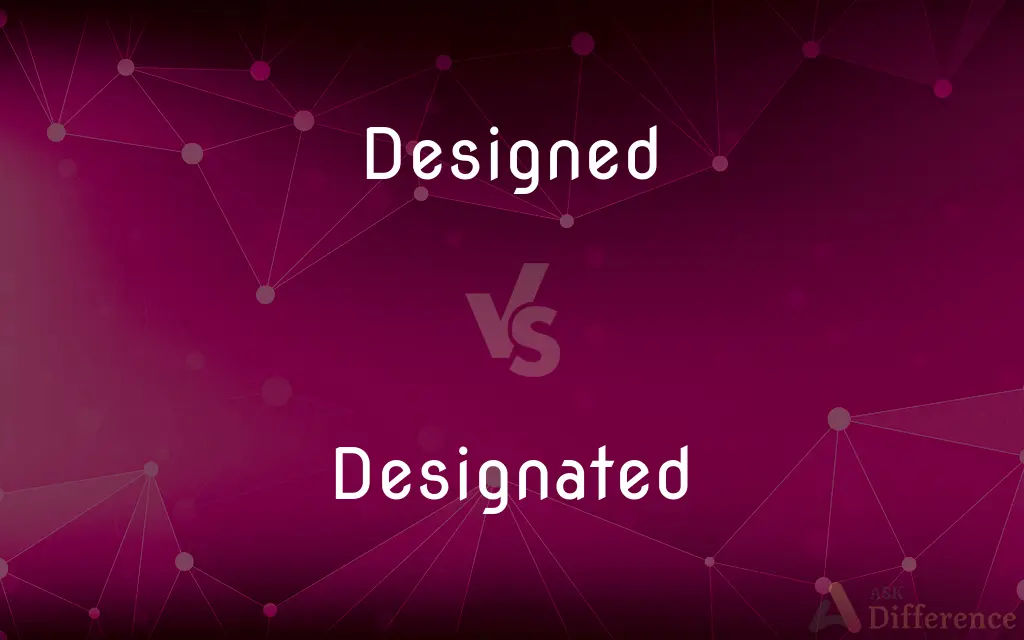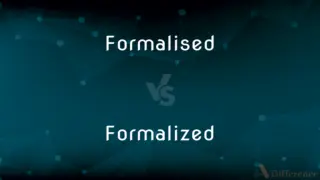Designed vs. Designated — What's the Difference?
By Maham Liaqat & Urooj Arif — Updated on March 22, 2024
Designed involves creating or planning something with intention, while designated refers to assigning a particular status or purpose to something or someone.

Difference Between Designed and Designated
Table of Contents
ADVERTISEMENT
Key Differences
Designed focuses on the creative process, where an individual or team conceptualizes and plans an object, system, or process. This involves considerations of aesthetics, functionality, and usability. On the other hand, designated is about naming or assigning someone or something to a specific role, position, or purpose without necessarily involving a creative process.
When something is designed, it goes through a phase of ideation, sketching, modeling, and testing to ensure it meets the intended goals. Whereas, designation often follows decision-making processes where a choice is made to allocate a name, function, or role to a person or object, which may not require creative input.
Designing often requires a deep understanding of the problem, target audience, and context to create effective and innovative solutions. Designated, in contrast, might simply be the act of identifying or labeling without needing to understand these underlying complexities.
The outcome of a design process is typically a tangible product, service, or system that aims to address specific needs or challenges. In contrast, the result of designation is the recognition or assignment of a person or thing to a specific category or role, which may not result in a physical outcome.
Design requires skills in creativity, problem-solving, and technical competence to bring a concept to life. Designation, however, primarily relies on the authority or decision-making capability to assign roles or labels, which may not involve creative skills.
ADVERTISEMENT
Comparison Chart
Definition
The process of creating something with a specific purpose.
Assigning a name, role, or purpose to someone or something.
Primary Focus
Creativity and innovation.
Assignment and recognition.
Skills Required
Creativity, technical skills, problem-solving.
Decision-making, authority.
Outcome
A tangible product, system, or service.
A status, role, or label assigned.
Process Involved
Ideation, sketching, modeling, testing.
Decision-making, naming, allocating.
Compare with Definitions
Designed
Conceptualized with creativity and innovation.
The new model of the car was designed with sustainability in mind.
Designated
Specified or identified for a particular purpose.
That area has been designated for residential development.
Designed
Created according to specific principles or ideas.
The software interface was designed for ease of use.
Designated
Allocated to a particular position or status.
Funds were designated for the health and education sector.
Designed
Structured or organized in a particular way.
The experiment was designed to test the hypothesis accurately.
Designated
Officially assigned to a particular role or category.
She was designated as the team leader for the project.
Designed
Formulated to address a particular problem or need.
The course was designed to improve students' critical thinking skills.
Designated
Named or labeled in a specific context.
The chemical is designated as a hazardous material.
Designed
Planned and executed with intention.
The building was designed by a renowned architect.
Designated
Chosen to carry out a specific task or duty.
A meeting room was designated for the negotiations.
Designed
Planned or conceived in detail or for a specific purpose
Specially designed buildings
The aircraft performed their designed functions well
Designated
To indicate or specify; point out
A fence that designates the property boundary.
Designed
To conceive or fashion in the mind; invent
Design a good excuse for not attending the conference.
Designated
To give a name or title to; characterize
The 1920s have been designated as the "Roaring Twenties.".
Designed
To formulate a plan for; devise
Designed a marketing strategy for the new product.
Designated
To select and set aside for a duty, office, or purpose
Designated a delegate to represent our department.
Designated funds for the project.
Designed
To make a graphic or schematic representation of (something), especially as a plan for its structure
Design a building on a computer.
Design a new car model.
Designated
Appointed but not yet installed in office
The commissioner designate.
Designed
To create or contrive for a particular purpose or effect
A game designed to appeal to all ages.
Designated
Simple past tense and past participle of designate
Designed
To have as a goal or purpose; intend
"Mrs. Bennet had designed to keep the two Netherfield gentlemen to supper.
But ... she had no opportunity of detaining them" (Jane Austen).
Designated
Having a specified designation
Designed
To make or execute plans.
Designated
Selected or named for a duty;
Designated hitter
Designed
To create designs.
Designed
A drawing or sketch.
Designed
A graphic representation, especially a detailed plan for construction or manufacture.
Designed
An ornamental pattern.
Designed
The purposeful or inventive arrangement of parts or details
The aerodynamic design of an automobile.
The design of an epic poem.
Designed
A particular plan or method
The party's design for increasing voter turnout.
Designed
The art or practice of designing or making designs
Studied design in college.
Designed
A reasoned purpose; an intent
It was her design to set up practice on her own as soon as she was qualified.
Designed
Deliberate intention
He became a photographer more by accident than by design.
Designed
Often designs A secretive or underhanded plot or scheme
He has designs on my job.
Designed
Simple past tense and past participle of design
Designed
Created according to a design
Designed
(dated) Planned; designated.
Designed
Planned or created in an artistic or skilled manner;
A beautifully designed dress
Some Italian designed sandals have cushioning
Designed
Done or made or performed with purpose and intent;
Style...is more than the deliberate and designed creation
Games designed for all ages
Well-designed houses
Designed
Carefully practiced or designed or premeditated;
A studied reply
Designed
Organized so as to give configuration to;
A magnet is surrounded by a configured field
A vehicle designed for rough terrain
Common Curiosities
How does designation differ from design?
Designation involves assigning a name, role, or purpose, whereas design involves the creative process of creating something.
How important is the role of decision-making in designation?
Decision-making is crucial in designation, as it involves selecting or naming someone or something for a specific role or purpose.
Is designing always a creative process?
Yes, designing is inherently a creative process that involves innovation and problem-solving.
Is designation always a formal process?
Designation can be both formal and informal, depending on the context and the authority of the assigning party.
How does context affect designing and designation?
The context influences designing in terms of needs and constraints, while it affects designation in terms of relevance and appropriateness of roles or labels.
What does it mean to design something?
Designing something means creating and planning it with a specific purpose, function, or aesthetic in mind.
Can a person be both designed and designated?
A person cannot be designed, but they can be designated to a particular role or title.
How does the outcome of designing differ from that of designation?
The outcome of designing is a tangible product or system, while designation results in an assigned role or label.
Can something be designed without being designated?
Yes, an object or system can be designed without necessarily being designated for a specific role or purpose immediately.
Can the design process involve designation?
Yes, part of the design process can involve designation, such as naming parts of a system or assigning roles within a designed structure.
Are technical skills required for both designing and designating?
Technical skills are primarily required for designing, while designating often requires decision-making and authority more than technical skills.
How does creativity play a role in designing and designating?
Creativity is central to designing for generating innovative solutions, whereas it plays a lesser role in the process of designation.
What is an example of a designation without a design process?
Naming a building after a person is an example of designation without a design process involved.
Can the process of designation affect the design of something?
Yes, the process of designation can influence the design, especially if certain roles or functions are predetermined.
Is user experience considered in both designing and designation?
User experience is a central concern in designing, whereas it may not be directly relevant to the process of designation.
Share Your Discovery

Previous Comparison
Goomah vs. Goombah
Next Comparison
Formalised vs. FormalizedAuthor Spotlight
Written by
Maham LiaqatCo-written by
Urooj ArifUrooj is a skilled content writer at Ask Difference, known for her exceptional ability to simplify complex topics into engaging and informative content. With a passion for research and a flair for clear, concise writing, she consistently delivers articles that resonate with our diverse audience.














































